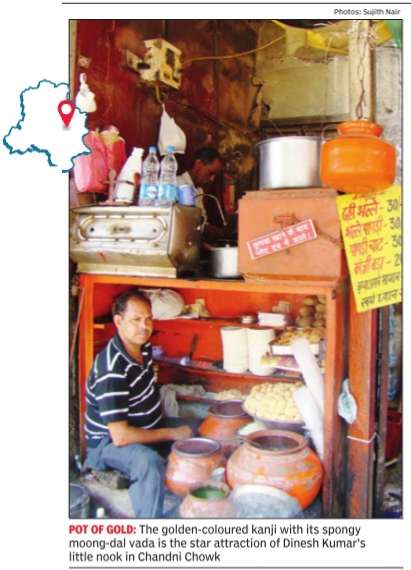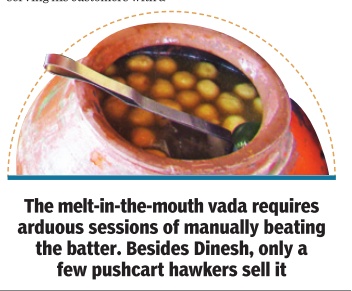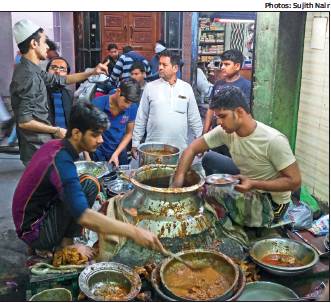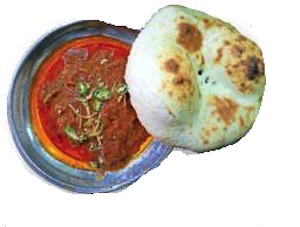Delhi: Cuisine
This is a collection of articles archived for the excellence of their content. |
Kanji Vada
The Times of India, September 26, 2015


Dinesh Kumar, who sells kanji vada -from an alcove in a wall, which he shares with a chaiwala -said he would grant me a three-minute interview. He sits opposite a bridal-wear store, which till a few months ago housed the iconic sweetshop, Ghantewala, in Chandni Chowk.
“Kanji vada is a traditional recipe common to Vaishya, Khatri and Kayasthcuisines.It used to be prepared for Holi and during marriages,“ says food historian Pushpesh Pant. “Alas, it has become almost extinct.“
Dinesh says the entire family gets involved in the preparation at their rented house in Mori Gate. A few pots of kanji are made daily and left to ferment. Vadas, red meetha chutney and pudina chutney are prepared fresh. Sundays, when his shop is closed, are spent in making masalas that he sprinkles liberally over his dahibhalla and bhallapapdi.
Dinesh says the spongy moong dal vadas and kanji, which customers find so irresistible that they keep asking for refills, are the result of backbreaking effort -the reason why it's becoming a dying art. Apart from Dinesh, just a few push-cart hawkers sell it in Old Delhi.
Pant says the melt-in-the-mouth vada requires hard labour, involving arduous sessions of beating the batter with hands; the kanji has no other ingredients save mustard powder and salt.Apart from its great taste, kanji is also traditionally regarded as a good digestive.
Nihari
Sujith Nair, Served at dusk, this nihari’s worth the wait, March 4, 2018: The Times of India

From: Sujith Nair, Served at dusk, this nihari’s worth the wait, March 4, 2018: The Times of India
The Mughal-era meat preparation takes an entire day to cook, and many of its makers in Old Delhi come from a single extended family
It’s a meat stew that is cooked overnight and traditionally consumed at the crack of dawn with khameeri roti. But at least one Old Delhi shop has upended the nihari tradition.
“Come after dusk” is what you are told at Kallu’s if you happen to land up at the shop to relish this Mughalera breakfast.
It’s a shop with no signboard in one of the bylanes behind Delite Cinema in Daryaganj. Kallu’s nihari is hard to get unless you make it there within an hour after it’s ready to serve in the evening.
Mohammed Rehan, 28 and one of the youngest nihari makers in Old Delhi, relies on his grandfather’s recipe that was perfected by his father, Rafiquddin, alias Kallu.
Kallu, who passed away two years ago, started this shop in the late 1980s, around the same time when his cousin set up his eatery, Sheedu Nihari, near Turkman Gate. All of them, including Noora in Sadar Bazaar’s Bara Hindu Rao, are related and have learned nihari making at their family-run shop near Kalan Masjid in Turkman Gate area.
Rehan uses 50kg of buffalo meat for his nihari daily, barring Sundays, when the shop is shut. Work begins at 7am. Ghee is the first to hit the woodfired degh, followed by sliced onions and garlic. A few minutes later the meat chunks are dropped in.
Alongside, in another smaller vessel, around 20 maghaz (goat heads) are boiled in water over low charcoal fire.
Half an hour later, the contents of the degh get one good stir and in goes red chilli powder, masala (a blend of 20 spices sourced from Khari Baoli) and salt. This is followed by a shower of dried, caramelised onion powder.
An hour later, atta mixed in water is poured into the degh. As the stew slowly thickens, the stirring gets more vigorous. Workers light up extra wooden logs to keep the degh boiling for the next two hours.
Meanwhile, water is drained off the smaller vessel and each maghaz is checked. Those with cracks are wrapped with threads before being put into the degh along with raw nalli (bone marrow).
The degh is closed with an earthen lid and the mouth sealed with a long wet cloth. Two jute sacks are then wrapped around the degh from both sides and the nihari left to cook in low charcoal fire till the shop opens for the public at 5.30pm.
As expectant customers mill around, the seal is opened and the nalli and the maghaz are removed from the degh and kept aside for those who want to have their nihari with either or both.
By now a small crowd builds up in front of the shop, choking movement in the narrow lane. Rehan, along with his three brothers, fill up plates with nihari, top it with sliced green chillies and ginger and serve it with khameeri rotis.
Some prefer eating it inside the shop, sitting cross-legged on the floor, near the tandoor, while others lap it up standing in the lane.
If you still insist on nihari for breakfast, head to Shabrati Nihari in Jama Masjid’s Chitli Qabar area. But, mind you, they make only a small quantity overnight with around 12kg meat. So, the early bird grabs the nihari!
